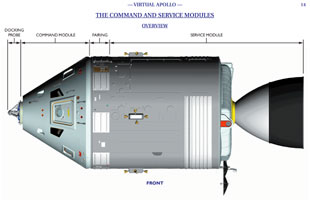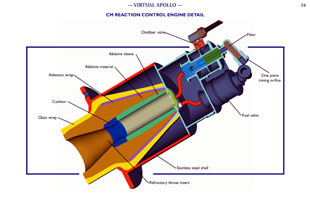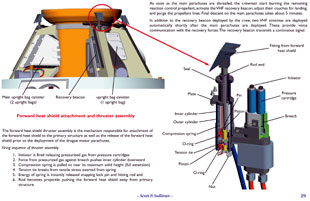|
|

|
Virtual Apollo: A Pictorial Essay of the Engineering and Construction of the Apollo Command and Service Modules
by Scott P. Sullivan
Apogee Books, 2003
Review by Karl Tate
In the early days of Star Trek fandom, artists such as Franz Joseph fleshed out the fictional Starship Enterprise with diagrams, blueprints and technical manuals showing how the spacecraft would have "really" functioned. Studying those drawings gave you a powerful sense of being in the corridors and crawlways of an actual space vehicle.
Scott Sullivan has done historians and fans of the space program a similar service with his new book "Virtual Apollo". WIth colorful renderings brought to three- dimensional life in his computer, Sullivan takes us into the very real Apollo spacecraft that astronauts first rode around the Moon in 1968.

Unlike most of Apogee's previous releases, most of which reprint NASA reports from the space missions themselves, "Virtual Apollo" is composed of entirely new renderings of the Command and Service Modules, plus the protective cover and escape rocket that sat atop them on the Saturn launch vehicle. Sullivan built more than 200 painstakingly accurate computer models for this project.
Sullivan, an engineer himself, amassed NASA and contractor reference material including drawings, photographs, even stills from the movie "Apollo 13", which featured incredibly realistic spacecraft sets.

This book goes step by step through every component of the Apollo vehicle, showing mechanisms and interior views with unbelievable detail. Vivid, solid colors are used for ease in visually separating the complex assemblies shown in the book's hundreds of illustrations.
"Virtual Apollo" features an unusual vertical layout, meaning that the pages are landscape format but bound on the "long" side (you have to turn the book sideways to read it). Mr. Sullivan indicates that the book was originally intended to be bound in a true landscape format, but the difficulty of getting the book seen on crowded bookstore shelves nixed that concept.

Mr. Sullivan designed the book's layout himself, designing the pages as slides in PowerPoint and giving the book a focused, graphically intensive presentation. The computer renderings are the star here, and Sullivan's supporting text is largely culled from NASA publications.
If the book has a flaw it is that - unlike most Apogee releases - it contains no CD-ROM! It would have been a "natural" for Sullivan's computer models to be displayed in all three dimensions on the computer screen. Even a "flat" format like Quicktime VR - or at least video "movies" derived from Sullivan's 3D graphics - would have added tremendously to this already exciting package.
Even as it is, "Virtual Apollo" is a boon both for readers interested in how America's manned lunar-orbiting spacecraft worked, and also for modellers who will treasure the intricate detail in the book's illustrations.
Sullivan is currently working on a similar volume illustrating the complexities of the Apollo Lunar Module; he says he would also like to create a third volume to feature the Mercury and Gemini spacecraft.
|

© 2022 collectSPACE.com All rights reserved.
Questions? E-mail contact@collectspace.com
|
|

|

|




